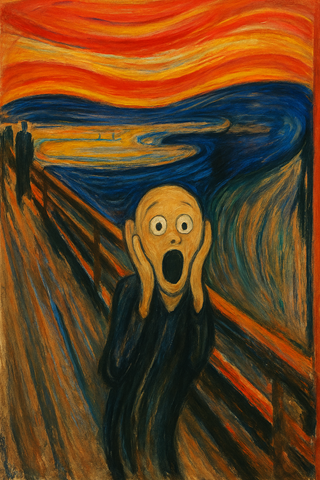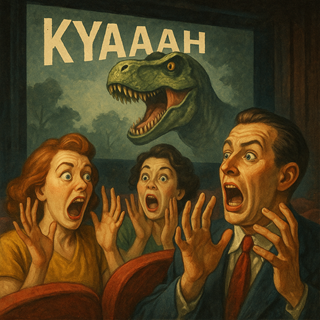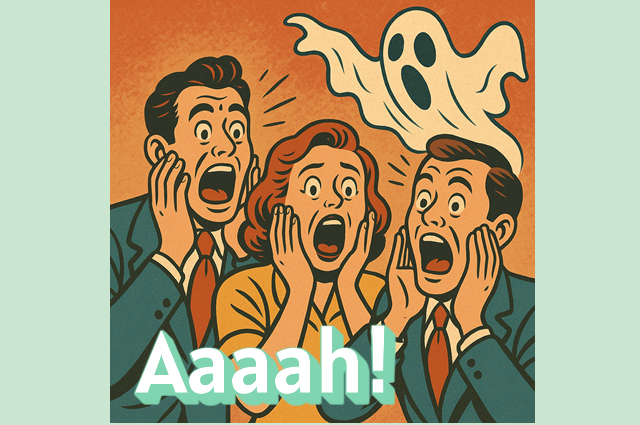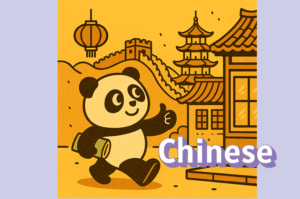Ever stubbed your toe, saw a ghost, or got overly excited at a concert?
In Japanese, it might be kyaa! (きゃー!) — a high-pitched, piercing cry of surprise or fear.
But how do people scream in other languages?
Let’s take a look at how different cultures express that sudden burst of emotion through sound.
What Does a Real Scream Sound Like?
First of all, listen carefully to what a scream actually sounds like.
It can be sharp, short, long, soft, or explosive — depending on the emotion behind it.
Japanese: きゃー / ぎゃー (Kyaa / Gyaa)
In Japanese, screams often begin with K or G sounds — like kyaa! (きゃー) for surprise or fear, or gyaa! (ぎゃー) for something more intense or loud.
These sounds reflect emotional outbursts, and are used both in real speech and manga/anime.
Example
きゃー!びっくりした!
(Kyaa! Bikkuri shita!)
Aah! That scared me!
How Do You Say It?
English: Aaaah! / Eek! / Yaaaah!
In English, there are several types of scream sounds:
Yaaaah! — a more aggressive or excited shout
Aaaah! — a general scream of fear or surprise
Eek! — a smaller, sharp cry (often associated with spotting a mouse!)
Example
She opened the door and screamed, ”Aaaah!”
How Do You Say It?
Chinese: 啊! / 哎呀!(Ā! / Āiyā!)
In Mandarin Chinese, scream-like expressions include:
- 啊! (ā!) — short, startled cry
- 哎呀! (āiyā!) — surprise, pain, or minor shock
They’re often used with tone and context rather than length.
Example
她突然大叫:“啊!”
(Tā tūrán dà jiào: “Ā!”)
She suddenly screamed, “Ah!”
How Do You Say It?
German: Aaaah! / Hilfe!
German often uses Aaaah! just like English, but in many situations, you might hear “Hilfe!” (Help!) shouted instead of a scream sound.
Screams may also be expressed with repetition: “Aaah! Aaah!”
Example
Sie rief: “Aaaah!”
(She shouted, “Aaaah!”)
How Do You Say It?
French: Aaah ! / Hii !
French also uses Aaah! for a general scream, but Hii! may appear in cartoons or comics to express fright or surprise.
It’s often written with extra letters like “Aaaaah !” to show volume or intensity.
Example
Elle a crié : “Aaaah !”
(She screamed: “Aaaah!”)
How Do You Say It?
Italian: Aaah! / Ahi!
In Italian, Aaah! works for screams, but Ahi! is more commonly used for pain.
Screams are usually expressive and theatrical, often stretched out with extra vowels.
Example
Aaah! Che paura!
(Aaah! How scary!)
How Do You Say It?
Korean: 꺄악! / 아악! (Kkyak! / Aak!)
In Korean, screams are written like 꺄악! (kkyak!) or 아악! (aak!).
These expressions are very similar to Japanese in tone and use, often showing fear, shock, or emotional bursts.
Example
그녀는 소리쳤다. “꺄악!”
(Geunyeoneun sorichyyeotda. “Kkyak!”)
She screamed, “Kkyak!”
How Do You Say It?

Screaming Sounds Starting with “K” in Japanese and Korean
When people are startled, they unconsciously produce sounds that are easiest to pronounce in that moment.
During fear or sudden surprise, the breath bursts out all at once —
the back of the throat reacts with a sharp “kah!” sound.
That’s why the sounds k and kk (in Korean) — called voiceless velar plosives — appear naturally in screams.
Common Features of Japanese Kyaa and Korean Kkyak (꺄악)
| Language | Onomatopoeia | Pronunciation | Emotion |
|---|---|---|---|
| 🇯🇵 Japanese | きゃー | kyaa | Surprise, fear, scream |
| 🇰🇷 Korean | 꺄악 | kkyak | Same — surprise, fear, scream |
Both use a high pitch + an explosive consonant (k/kk) —
a combination that closely resembles an actual sharp scream.
It perfectly matches the “emergency reaction” of exhaling all at once.
Then Why Don’t English or French Start with “K”?
In languages like English, screams are often expressed through vowel‑based sounds such as
“Aaaah!”, “Eek!”, or “Yaaaah!”.
These reflect a cultural tendency to describe emotion through tone and duration,
rather than reproducing the exact physical sound.
In contrast, Japanese and Korean capture the bodily realism of the voice itself —
a sound that feels closer to how a real scream is physically produced.

Are Screams Cultural or Instinctive?
While the style of expression varies across languages,
the ease of pronunciation in moments of shock seems deeply instinctive.
“Aaaah!”, “Kyaa!”, and “Kkyak!” — all are shaped by the same human reaction: sudden surprise.
When we compare onomatopoeia from around the world,
we’re not just exploring sound — we’re discovering the shared humanity that breathes behind every scream.
Final Thoughts
Even though screams may sound similar around the world, the way we write or imitate them varies greatly.
Some languages — like Japanese and Korean — use sharp, consonant-heavy sounds like kyaa or kkyak.
Others rely more on vowels — Aaaah, Eek, Āiyā — to express the feeling.
In the end, scream onomatopoeia are not just emotional sounds —
they’re tiny mirrors reflecting how each culture hears fear, surprise, and excitement.
Which one would you scream if a ghost popped out of nowhere?












Comments